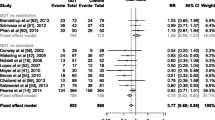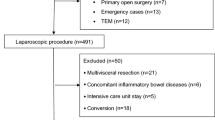Abstract
A correct perioperative fluid administration represents one of the most important items proposed by the Enhanced Recovery After Surgery Society. Upper gastrointestinal (UGI) surgery patients undergoing major oncological procedures are often elderly and frail. Should we prefer a wet or a dry patient? Both conditions should probably be avoided in this surgical setting. We present a narrative review on perioperative fluid administration in UGI patients undergoing major surgery, also analyzing the role of Goal Directed therapy.
Similar content being viewed by others
Availability of data and materials
All data generated or analyzed during this study are included in this published article.
Code availability
Not applicable.
References
Feldheiser A, Aziz O, Baldini G et al (2016) Enhanced Recovery After Surgery (ERAS) for gastrointestinal surgery, part 2: consensus statement for anaesthesia practice. Acta Anaesthesiol Scand 60(3):289–334
Braga M, Scatizzi M, Borghi F et al (2018) Identification of core items in the enhanced recovery pathway. Clin Nutr ESPEN 25:139–144
Myles PS, Bellomo R, Corcoran T et al (2018) Restrictive versus liberal fluid therapy for major abdominal surgery. N Engl J Med 378:2263–2274
Wijnberge M, Schenk J, Bulle E et al (2021) Association of intraoperative hypotension with postoperative morbidity and mortality: systematic review and meta-analysis. BJS Open 5(1):zraa018
Low DE, Allum W, De Manzoni G et al (2019) Guidelines for perioperative care in esophagectomy: Enhanced Recovery After Surgery (ERAS) society recommendations. World J Surg 43(2):299–330
Wagner D, De Marco MM, Amini N et al (2016) Role of frailty and sarcopenia in predicting outcomes among patients undergoing gastrointestinal surgery. World J Gastrointest Surg 8(1):27–40
Deng HY, Zha P, Peng L et al (2018) Preoperative sarcopenia is a predictor of poor prognosis of esophageal cancer after esophagectomy: a comprehensive systematic review and meta-analysis. Dis Esophagus 32(3):1–10
Parise P, Elmore U, Fumagalli U et al (2016) Esophageal surgery in Italy. Criteria to identify the hospital units and tertiary referral centers entitled to perform it. Upadates Surg 68(2):129–133
American Cancer Society (2019) Cancer Facts & Figures. Atlanta Am Cancer Soc.2019.
Talavera-Urquijo E, Parise P, Palucci M et al (2020) Perfusion speed of indocyanine green in the stomach before tubulization is an objective and useful parameter to evaluate gastric microcirculation during Ivor-Lewis esophagectomy. Surg Endosc 34(12):5649–5659
Kamarajah SK, Lin A, Tharmaraja T et al (2020) Risk factors and outcomes associated with anastomotic leak after esophagectomy: a systematic review and meta-analysis. Dis Esophagus 33(3):doz 089
Theodorou D, Drimousis PG, Larentzakis A et al (2008) The effects of vasopressors on perfusion of gastric graft after esophagectomy. An experimental study. J Gastrointest Surg 12(9):1497–1501
Mortensen K, Nilsson M, Slim K et al (2014) Consensus guidelines for enhanced recovery after gastrectomy. Brit J Surg 101(10):1209–1229
Xing X, Gao Y, Wang H et al (2015) Correlation of fluid balance and postoperative pulmonary complications in patients after esophagectomy for cancer. J Thorac Dis 7(11):1986–1993
Eng OS, Arlow RL, Moore D et al (2016) Fluid administration and morbidity in transhiatal esophagectomy. J Surg Res 200(1):91–97
Rl NG, Thomson IG, Smithers BM et al (2020) Intraoperative fluid restriction during enhanced recovery after surgery versus liberal fluids for esophagectomy: a single center retrospective pilot study. J Clin Anesth 67:110030
Van Dessel E, Moons J, Nafteux P et al (2021) Perioperative fluid management in esophagectomy for cancer and its relation to postoperative respiratory complications. Dis Esophagus 34(7):doaa 111
Klevebro F, Boshier PR, Low DE (2019) Application of standardized hemodynamic protocols within enhanced recovery after surgery programs to improve outcomes associated with anastomotic leaks and conduit necrosis in patients undergoing esophagectomy. J Thoracic Dis 11(Suppl5):S692-701
Bahlmann H, Halldestam I, Nilsson L (2019) Goal-directed therapy during transthoracic oesophageal resection does not improve outcome: Randomised Controlled Trial. Eur J Anaesthesiol 36(2):153–161
Mukai A, Suehiro K, Watanabe R et al (2020) Impact of intraoperative goal-directed fluid therapy on major morbidity and mortality after transthoracic oesophagectomy: a multicentre, randomized controlled trial. B J Anaesth 125(6):953–961
Wijnberge M, Geerts BF, Hol L et al (2020) Effect of a machine learning-derived early warning system for intraoperative hypotension vs standard care on depth and duration of intraoperative hypotension during elective noncardiac surgery: the HYPE randomized clinical trial. JAMA 323(11):1052–1060
Kingma BF, Eshuis WJ, de Groot EM et al (2020) Paravertebral catheter versus epidural analgesia in minimally invasive esophageal resections: a randomized controlled multicenter trial (PEPMEN trial). BMC Cancer 20:142
Funding
The authors did not receive support from any organization for the submitted work.
Author information
Authors and Affiliations
Corresponding author
Ethics declarations
Conflict of interest
The authors have no financial or proprietary interests in any material discussed in this article. All the authors declare no potential conflicts of interest.
Research involving human participants and/or animals
This research does not involve human participants and/or animals.
Informed consent
Considering the type of publication (systematic review), an informed consent was not necessary.
Additional information
Publisher's Note
Springer Nature remains neutral with regard to jurisdictional claims in published maps and institutional affiliations.
Rights and permissions
Springer Nature or its licensor holds exclusive rights to this article under a publishing agreement with the author(s) or other rightsholder(s); author self-archiving of the accepted manuscript version of this article is solely governed by the terms of such publishing agreement and applicable law.
About this article
Cite this article
Turi, S., Marmiere, M. & Beretta, L. Dry or wet? Fluid therapy in upper gastrointestinal surgery patients. Updates Surg 75, 325–328 (2023). https://doi.org/10.1007/s13304-022-01352-z
Received:
Accepted:
Published:
Issue Date:
DOI: https://doi.org/10.1007/s13304-022-01352-z




